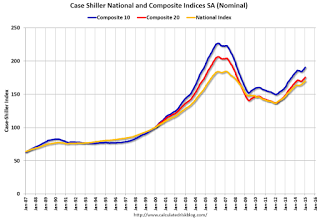After a week loaded with economic data there are plenty of fresh economic worries. In addition, the Fed seems ready to act in spite of some weak data. This means that good news is (finally) good news, and bad news will be bad. For economic and market skeptics, it signals a market shift that they see as long overdue.
Does a market correction loom?
Prior Theme Recap
In my last WTWA I predicted that market observers would be asking whether it was time for an economic spring thaw. That was the right question, with soft data during a busy week leading to a strong initial claims report on Thursday. Friday’s employment report gave a rounding answer – No! – to the spring thaw question. While the stock market was closed, futures trading implies one of those “triple digit†down openings on Monday.
Feel free to join in my exercise in thinking about the upcoming theme. We would all like to know the direction of the market in advance. Good luck with that! Second best is planning what to look for and how to react. That is the purpose of considering possible themes for the week ahead.
This Week’s Theme
The upcoming week reverses last week’s calendar effect.
- The big reports are bunched at the end of one month and the start of the next. We get a very thin serving of fresh data this week.
- It is too soon for the hard news from earnings reports (although we get the unofficial start to the season with Alcoa on Wednesday).
Last week I expected position-squaring in front of Friday’s news, and that seemed to happen. This leaves us with a negative bias for the week ahead (despite Felix’s bullish call – see below).
In the absence of more compelling news, I expect serious discussion about the potential market downside. Look for pundits to be asking:
Is there a correction looming?
The Viewpoints
The viewpoints include those focused on the economy and those more interested in stocks.
A correction is imminent.
- We are seeing pervasive softening in the economy. The extreme observers think that we are already in a recession and even some mainstream sources have upped the odds to 50%. Nearly everyone agrees that the rate of growth is significantly lower, adjusting forecasts accordingly. Hale Stewart is raising a caution flag.
- A pullback in stocks is long overdue. Traders are reaching out for inverse ETFs (ETF Trends).
- Expect a sideways market. There may be a healthy dip (up to 10%) but it is the entry point many investors have waited for.
- Be a contrarian! Nearly everyone is negative. Some see the results as weather, port work stoppages, and the temporary effects of a stronger dollar. (See employment report links below).
As always, I have my own ideas in today’s conclusion. But first, let us do our regular update of the last week’s news and data. Readers, especially those new to this series, will benefit from reading the background information.
Last Week’s Data
Each week I break down events into good and bad. Often there is “ugly†and on rare occasion something really good. My working definition of “good†has two components:
- The news is market-friendly. Our personal policy preferences are not relevant for this test. And especially – no politics.
- It is better than expectations.
The Good
There was some good news last week.
- Initial jobless claims. 268K was in line with the lowest readings from recent years. The period was not part of the survey for the payroll report, so it is “more recent†news and less subject to revision.
- Auto sales hit a new recent high, as seasonally adjusted annual rate of 17.05 million. (Calculated Risk).
- The trade balance improved nicely, but the gains are deceptive – mostly the result of a rebound after the West Coast port work stoppages. (Diane Swonk).
- The US has a preliminary nuclear deal with Iran. Many will not like the policy, and it is far from a done deal. (See this Brookings post on discrepancies in the Iran domestic presentation). Stocks shrugged, but oil prices declined sharply on the news. The energy reaction seems overdone, but for now we will call this a positive.
- Consumer confidence (via the Conference Board) moved higher and beat expectations. See the analysis and great chartsfrom Doug Short.
- Pending home sales. Growth of 3.1% handily beat expectations. (Calculated Risk).
- Home prices. Case-Shiller data from 20 cities continues to show growth in both nominal and real gains. Calculated Risk is the go-to source on all things housing, and this is a helpful chart:

Â
The Bad
There discouraging news on the most important economic reports.
- Consumer spending lagged, rising only 0.1%, below expectations.
- Construction spending fell, a decline of 0.1%. (See chart in Quant Corner).
-
ISM manufacturing missed expectations and continued the recent decline. While the level still signals expansion (51.5) it was a disappointment that left observers wondering when the decline might end. Here is some color commentary from theISM site:
WHAT RESPONDENTS ARE SAYING …
“Falling energies have helped on the cost side while sales are getting a boost through improvements in consumer disposable income.†(Food, Beverage & Tobacco Products)
“Our business is still strong and on projection. Dollar strength is challenging for our international business.†(Fabricated Metal Products)
“Business is still extremely strong.†(Transportation Equipment)
“Oil prices impacting drilling and project activity. Pursuing cost reductions from suppliers for a wide variety of goods and services.†(Petroleum & Coal Products)
“Business really starting to slow down. Oil pricing is having a major effect on energy markets.†(Computer & Electronic Products)
“Steady Q1 demand but somewhat interrupted by weather.†(Primary Metals)
“Operating costs are higher due to increases in healthcare premiums.†(Miscellaneous Manufacturing)
“March business is improving over Jan-Feb, thawing out of this crazy winter.†(Paper Products)
“Dealing with ongoing delivery issues associated with congestion at the U.S. West Coast and Vancouver ports.†(Machinery)
“Congestion at the West Coast ports delaying incoming products.†(Textile Mills)

